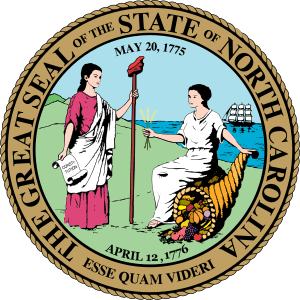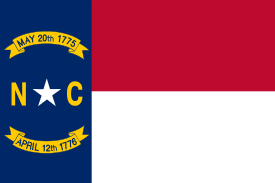Orange County, North Carolina
Orange County is a county located in the U.S. state of North Carolina. As of the 2010 census, the population was 133,801.[1] Its county seat is Hillsborough.[2]
Orange County | |
|---|---|
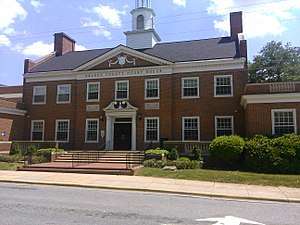 Orange County Courthouse | |
 Seal | |
 Location within the U.S. state of North Carolina | |
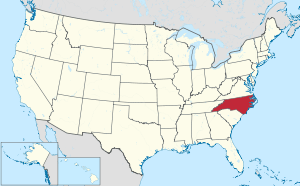 North Carolina's location within the U.S. | |
| Coordinates: 36°04′N 79°07′W | |
| Country | |
| State | |
| Founded | 1752 |
| Named for | William V of Orange |
| Seat | Hillsborough |
| Largest town | Chapel Hill |
| Area | |
| • Total | 401 sq mi (1,040 km2) |
| • Land | 398 sq mi (1,030 km2) |
| • Water | 3.5 sq mi (9 km2) 0.9%% |
| Population | |
| • Estimate (2019) | 148,476 |
| • Density | 336/sq mi (130/km2) |
| Time zone | UTC−5 (Eastern) |
| • Summer (DST) | UTC−4 (EDT) |
| Congressional district | 4th |
| Website | orangecountync |
Orange County is included in the Durham–Chapel Hill, NC Metropolitan Statistical Area, which is also included in the Raleigh–Durham–Chapel Hill, NC Combined Statistical Area, which had a 2012 estimated population of 1,998,808.[3]
It is home to the University of North Carolina at Chapel Hill, the flagship institution of the University of North Carolina System and the oldest state-supported university in the United States.
History
The county was formed in 1752 from parts of Bladen, Granville, and Johnston Counties. It was named for the infant William V of Orange, whose mother Anne, daughter of King George II of Great Britain, was then regent of the Dutch Republic.
In 1771, Orange County was greatly reduced in area. The western part of it was combined with the eastern part of Rowan County to form Guilford County. Another part was combined with parts of Cumberland County and Johnston County to form Wake County. The southern part of what remained became Chatham County.
In 1777, the northern half of what was left of Orange County became Caswell County. In 1849, the western county became Alamance County. Finally, in 1881, the eastern half of the county's remaining territory was combined with part of Wake County to form Durham County.
Some of the first settlers of the county were English Quakers, who settled along the Haw and Eno Rivers.[4] Arguably, the earliest settlers in the county were the Andrews family, which would later marry into the Lloyd family.[5]
Colonial period and Revolutionary War
The Orange County seat of Hillsborough was founded in 1754 on land where the Great Indian Trading Path crossed the Eno River, and was first owned, surveyed, and mapped by William Churton (a surveyor for Earl Granville). Originally to be named Orange, it was named Corbin Town (for Francis Corbin, a member of the governor's council and one of Granville's land agents), and renamed Childsburgh (in honor of Thomas Child, the attorney general for North Carolina from 1751–1760 and another one of Granville's land agents) in 1759. In 1766, it was named Hillsborough, after Wills Hill, then the Earl of Hillsborough, the British secretary of state for the colonies, and a relative of royal Governor William Tryon.

Hillsborough was an earlier Piedmont colonial town where court was held, and was the scene of some pre-Revolutionary War tensions. In the late 1760s, tensions between Piedmont farmers and county officers welled up in the Regulator movement, or as it was also known, the War of the Regulation, which had its epicenter in Hillsborough.[6] Several thousand people from North Carolina, mainly from Orange County, Anson County, and Granville County in the western region, were extremely dissatisfied with the wealthy North Carolina officials whom they considered cruel, arbitrary, tyrannical, and corrupt. With specie scarce, many inland farmers found themselves unable to pay their taxes and resented the consequent seizure of their property. Local sheriffs sometimes kept taxes for their own gain and sometimes charged twice for the same tax. At times, sheriffs would intentionally remove records of their tax collection to further tax citizens. The most heavily affected areas were said to be those of Rowan, Anson, Orange, Granville, and Cumberland Counties. It was a struggle of mostly lower-class citizens, who made up the majority of the population of North Carolina, and the wealthy ruling class, who composed about 5% of the population, yet maintained almost total control of the government. Of the 8,000 people living in Orange County at the time, an estimated 6000 - 7000 of them were in support of the Regulators.
Governor William Tryon's conspicuous consumption in the construction of a new governor's mansion at New Bern fuelled the movement's resentment. As the western districts were under-represented in the colonial legislature, obtain redress by legislative means was difficult for the farmers. Ultimately, the frustrated farmers took to arms and closed the court in Hillsborough, dragging those they saw as corrupt officials through the streets and cracking the church bell.[6] Tryon sent troops from his militia to the region, and defeated the Regulators at the Battle of Alamance in May 1771.[6] Several trials were held after the war, resulting in the hanging of six Regulators at Hillsborough on June 19, 1771.
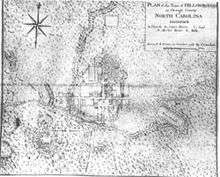
Hillsborough was used as the home of the North Carolina state legislature during the American Revolution.[7] Hillsborough served as a military base by British General Charles Cornwallis in late February 1781. The United States Constitution drafted in 1787 was controversial in North Carolina. Delegate meetings at Hillsboro in July 1788 initially voted to reject it for antifederalist reasons. They were persuaded to change their minds partly by the strenuous efforts of James Iredell and William Davie and partly by the prospect of a Bill of Rights. The Constitution was later ratified by North Carolina at a convention in Fayetteville.
William Hooper, a signer of the Declaration of Independence, was buried in the Presbyterian Church cemetery in October 1790. However, his remains were later reinterred at Guilford Courthouse Military Battlefield. His original gravestone remains in the town cemetery.
University of North Carolina
Chartered by the North Carolina General Assembly on December 11, 1789, the University of North Carolina's cornerstone was laid on October 12, 1793, near the ruins of a chapel, chosen due to its central location within the state.[8] Beginning instruction of undergraduates in 1795, UNC is the oldest public university in the United States and the only one to award degrees in the 18th century.[9][10]
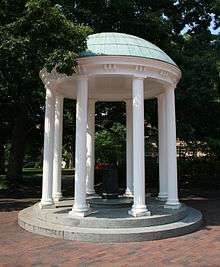
19th century
The Reverend Robert and Margaret Anna Burwell[11] founded and ran a school for girls called the Burwell School from 1837 to 1857 in their home on Churton Street in Hillsborough. When the Civil War began, Hillsborough was reluctant to support secession. However, many citizens went off to fight for the Confederacy. During the war, North Carolina Governor David Lowry Swain persuaded Confederate President Jefferson Davis to exempt some UNC students from the draft, so the university was among the few in the Confederacy that managed to stay open.[12] However, Chapel Hill suffered the loss of more of its population during the war than any village in the South. When student numbers did not recover, the university was forced to close during Reconstruction from December 1, 1870 to September 6, 1875.[13]
In March 1865, Confederate General Joseph E. Johnston wintered just outside Hillsborough at the Dickson home, which now serves as the Hillsborough Welcome Center in downtown (the house was moved from its original site in the early 1980s due to commercial development). The main portion of the Confederate Army of Tennessee was encamped between Hillsborough and Greensboro.
After his March to the Sea, while camped in Raleigh, Union General William T. Sherman offered an armistice to Johnston, who agreed to meet to discuss terms of surrender. Johnston, traveling east from Hillsborough and Sherman, traveling west from Raleigh along the Hillsborough-Raleigh Road, met roughly half-way near present-day Durham (then Durham Station) at the home of James and Nancy Bennett, a farmhouse now known as the Bennett Place. The two generals met on April 17, 18th, and finally on the 26th, which resulted in their agreeing to final terms of surrender. Johnston surrendered 89,270 Southern troops who were active in North Carolina, South Carolina, Georgia, and Florida. This was the largest surrender of troops during the war, and effectively ended the Civil War.[7]
20th century
Occoneechee Speedway, just outside Hillsborough, was one of the first two NASCAR tracks to open, and is the only track remaining from that inaugural 1949 season. Bill France and the early founders of NASCAR bought land to build a one-mile oval track at Hillsborough, but opposition from local religious leaders prevented the track from being built in the town and NASCAR officials built the large speedway Talladega Superspeedway in Talladega, Alabama.[14]
Chapel Hill, along with Durham and Raleigh, makes up one of the three corners of the Research Triangle, so named in 1959 with the creation of Research Triangle Park, a research park between Durham and Raleigh.
The Morehead Planetarium at UNC was, when it opened in 1949, one of only a handful of planetariums in the nation, and it has remained an important town landmark for Chapel Hill. During the Mercury, Gemini, and Apollo programs, astronauts were trained there.
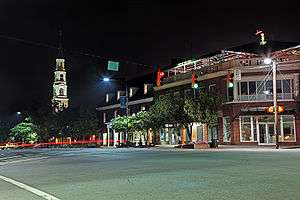
During the 1960s, the UNC campus was the location of significant political protest. Prior to the passage of the Civil Rights Act of 1964, protests about local racial segregation which began quietly in Franklin Street restaurants led to mass demonstrations and disturbance.[15] The climate of civil unrest prompted the 1963 Speaker Ban Law prohibiting speeches by communists on state campuses in North Carolina.[16] The law was immediately criticized by University Chancellor William Brantley Aycock and University President William Friday, but was not reviewed by the North Carolina General Assembly until 1965.[17] Small amendments to allow "infrequent" visits failed to placate the student body, especially when the university's board of trustees overruled new Chancellor Paul Frederick Sharp's decision to allow speaking invitations to Marxist speaker Herbert Aptheker and civil liberties activist Frank Wilkinson; however, the two speakers came to Chapel Hill anyway. Wilkinson spoke off campus, while more than 1,500 students viewed Aptheker's speech across a low campus wall at the edge of campus, christened "Dan Moore's Wall" by The Daily Tar Heel for Governor Dan K. Moore.[18] A group of UNC students along with Aptheker and Williamson filed a lawsuit in U.S. federal court, and on February 20, 1968, the Speaker Ban Law was struck down.[19]
In 1968, only a year after its schools became fully integrated, Chapel Hill became the first predominantly white municipality in the country to elect an African American mayor, Howard Lee. Lee served from 1969 until 1975 and, among other things, helped establish Chapel Hill Transit, the town's bus system.
Geography
According to the U.S. Census Bureau, the county has a total area of 401 square miles (1,040 km2), of which 398 square miles (1,030 km2) is land and 3.5 square miles (9.1 km2) (0.9%) is water.[20]
The county is drained, in part, by the Eno River.
The city of Chapel Hill, is in the southeastern part of Orange County, as is Carrboro. Hillsborough is in the central part of the county and is the county seat.
Adjacent counties
- Person County – northeast
- Durham County – east
- Chatham County – south
- Alamance County – west
- Caswell County – northwest
Demographics
| Historical population | |||
|---|---|---|---|
| Census | Pop. | %± | |
| 1790 | 12,216 | — | |
| 1800 | 16,362 | 33.9% | |
| 1810 | 20,135 | 23.1% | |
| 1820 | 23,492 | 16.7% | |
| 1830 | 23,908 | 1.8% | |
| 1840 | 24,356 | 1.9% | |
| 1850 | 17,055 | −30.0% | |
| 1860 | 16,947 | −0.6% | |
| 1870 | 17,507 | 3.3% | |
| 1880 | 23,698 | 35.4% | |
| 1890 | 14,948 | −36.9% | |
| 1900 | 14,690 | −1.7% | |
| 1910 | 15,064 | 2.5% | |
| 1920 | 17,895 | 18.8% | |
| 1930 | 21,171 | 18.3% | |
| 1940 | 23,072 | 9.0% | |
| 1950 | 34,435 | 49.3% | |
| 1960 | 42,970 | 24.8% | |
| 1970 | 57,707 | 34.3% | |
| 1980 | 77,055 | 33.5% | |
| 1990 | 93,851 | 21.8% | |
| 2000 | 118,227 | 26.0% | |
| 2010 | 133,801 | 13.2% | |
| Est. 2019 | 148,476 | [21] | 11.0% |
| U.S. Decennial Census[22] 1790-1960[23] 1900-1990[24] 1990-2000[25] 2010-2019[1] | |||
As of the 2010 United States Census, there were 133,801 people living in the county. 74.4% were White, 11.9% Black or African American, 6.7% Asian, 0.4% Native American, 4.0% of some other race and 2.5% of two or more races. 8.2% were Hispanic or Latino (of any race).
As of the census[26] of 2000, there were 118,227 people, 45,863 households, and 26,141 families living in the county. The population density was 296 people per square mile (114/km²). There were 49,289 housing units at an average density of 123 per square mile (48/km²). The racial makeup of the county was 78.05% White, 13.79% Black or African American, 0.39% Native American, 4.10% Asian, 0.02% Pacific Islander, 1.96% from other races, and 1.71% from two or more races. 4.46% of the population were Hispanic or Latino of any race.
There were 45,863 households out of which 28.30% had children under the age of 18 living with them, 44.60% were married couples living together, 9.40% had a female householder with no husband present, and 43.00% were non-families. 28.10% of all households were made up of individuals and 6.10% had someone living alone who was 65 years of age or older. The average household size was 2.36 and the average family size was 2.95.
In the county, the age distribution was as follows: 20.30% under the age of 18, 21.00% from 18 to 24, 29.90% from 25 to 44, 20.40% from 45 to 64, and 8.40% who were 65 years of age or older. The median age was 30 years. For every 100 females there were 90.10 males. For every 100 females age 18 and over, there were 86.70 males.
The median income for a household in the county was $42,372, and the median income for a family was $59,874. Males had a median income of $39,298 versus $31,328 for females. The per capita income for the county was $24,873. About 6.20% of families and 14.10% of the population were below the poverty line, including 9.00% of those under age 18 and 7.40% of those age 65 or over. FY 2008-09 Orange County had the second highest property tax rate in NC at 0.998 per $100 of valuation. For FY 2009-10 after the 2009 Orange County revaluation, the rate is now ninth highest in the state at 0.858 per $100 of valuation.
Communities
Cities
Towns
- Carrboro
- Chapel Hill (most, small portions in Durham and Chatham Counties)
- Hillsborough (county seat)
Census-designated place
Townships
- Bingham
- Cedar Grove
- Chapel Hill
- Cheeks
- Eno
- Hillsborough
- Little River
Unincorporated communities
- Blackwood
- Buckhorn (also known as Cheeks Crossroads)
- Caldwell
- Calvander
- Carr
- Cedar Grove
- Dodsons Crossroads
- Dogwood Acres
- Eno
- Eubanks
- Fairview, Hillsborough
- Hurdle Mills
- Laws
- McDade
- Miles
- Oaks
- Orange Grove
- Piney Grove
- Rougemont
- Schley
- Teer
- University (formerly known as Glenn)
- White Cross
Law and government
Orange County is governed by a seven-member board of commissioners. The commissioners are elected to four-year terms by district and at-large in partisan elections, which are held in November of even-numbered years. Orange County is a member of the regional Triangle J Council of Governments.
Politics
Orange County has gained a reputation as one of the most liberal counties in North Carolina. The county consistently delivers one of the largest Democratic majorities in the state in presidential, state, and local elections. This trend predates the recent swing toward the Democrats in counties dominated by college towns. The last Republican to win the county at a presidential level was Herbert Hoover in 1928[27] – when opposition to the Catholicism of Democratic nominee Al Smith was a powerful force among voters. It has only supported a Republican two other times since the Civil War–William Howard Taft in 1908 and William McKinley in 1900.[28] Since 1928, a Republican has only cleared 40 percent of the vote only five times, the last being Ronald Reagan in 1984.
| Year | Republican | Democratic | Third parties |
|---|---|---|---|
| 2016 | 22.5% 18,557 | 72.8% 59,923 | 4.7% 3,860 |
| 2012 | 28.1% 21,539 | 70.2% 53,901 | 1.7% 1,317 |
| 2008 | 27.1% 20,266 | 71.8% 53,806 | 1.1% 838 |
| 2004 | 32.4% 20,771 | 66.9% 42,910 | 0.7% 472 |
| 2000 | 36.3% 17,930 | 62.7% 30,921 | 1.0% 493 |
| 1996 | 32.2% 15,053 | 61.3% 28,674 | 6.5% 3,038 |
| 1992 | 27.5% 13,009 | 60.5% 28,595 | 12.0% 5,696 |
| 1988 | 39.1% 14,503 | 60.2% 22,326 | 0.6% 238 |
| 1984 | 43.0% 15,585 | 56.7% 20,564 | 0.4% 128 |
| 1980 | 32.4% 9,261 | 53.3% 15,226 | 14.4% 4,102 |
| 1976 | 36.9% 9,302 | 62.5% 15,755 | 0.7% 169 |
| 1972 | 47.7% 11,632 | 51.8% 12,634 | 0.6% 142 |
| 1968 | 33.3% 6,097 | 45.7% 8,366 | 21.0% 3,845 |
| 1964 | 38.6% 5,785 | 61.4% 9,206 | |
| 1960 | 42.2% 5,231 | 57.9% 7,180 | |
| 1956 | 48.1% 4,396 | 51.9% 4,743 | |
| 1952 | 42.5% 3,813 | 57.5% 5,156 | |
| 1948 | 31.0% 1,813 | 60.3% 3,523 | 8.7% 507 |
| 1944 | 30.9% 1,467 | 69.1% 3,274 | |
| 1940 | 23.1% 1,100 | 77.0% 3,673 | |
| 1936 | 27.3% 1,446 | 72.8% 3,860 | |
| 1932 | 26.5% 1,114 | 69.6% 2,924 | 3.9% 165 |
| 1928 | 58.8% 2,564 | 41.2% 1,799 | |
| 1924 | 35.4% 1,065 | 62.4% 1,879 | 2.2% 66 |
| 1920 | 46.6% 1,737 | 53.4% 1,993 | |
| 1916 | 48.5% 1,158 | 51.5% 1,230 | |
| 1912 | 8.6% 172 | 50.0% 997 | 41.4% 825 |
Chapel Hill and Carrboro have a reputation for being two of the most liberal communities in the Southern United States. Carrboro was the first municipality in North Carolina to elect an openly gay mayor, Mike Nelson (who also served as an Orange County commissioner from 2006 to 2010), and the first municipality in the state to grant domestic-partner benefits to same-sex couples. In October 2002, Carrboro was among the first municipalities in the South to pass resolutions opposing the Iraq War and the USA PATRIOT Act. Orange County voted 78.98% against Amendment 1. This was the highest vote against a constitutional ban on same-sex marriage of any county in the United States, even higher than San Francisco in 2008.[30]
Education
The county is served by 2 school districts:[31]
- Orange County Schools
- Chapel Hill-Carrboro
Notable people
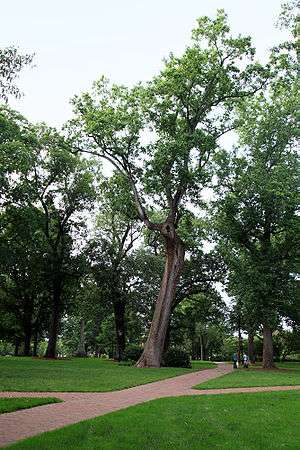
- Alice Adams, author, who grew up in Chapel Hill[32]
- K.A. Applegate, author
- Thomas Samuel Ashe, United States Congressman from North Carolina[33]
- Lewis Black, comedian
- David Brinkley, newscaster
- Fred Brooks, computer science pioneer
- Larry Brown, basketball coach
- Cam Cameron, football coach
- William Carter Love, U.S. Representative from North Carolina
- Spencer Chamberlain, musician
- Elizabeth Cotten, blues singer who grew up in Carrboro
- Floyd Council, blues singer, the "Floyd" in Pink Floyd
- Butch Davis, football coach
- Sarah Dessen, author
- Elizabeth Edwards, an attorney and activist for liberal causes, Chapel Hill
- John Edwards, former North Carolina Senator, 2008 Presidential candidate, Chapel Hill
- Sam Ervin, former North Carolina senator, chairman of the Senate Watergate Committee
- Lawrence Ferlinghetti, beat poet, co-founder of City Lights Booksellers
- Ben Folds, musician
- Paul Green, playwright
- Andy Griffith, actor
- Mia Hamm, soccer player
- Harpe Brothers, Micajah and Wiley, America's first serial killers
- Bunny Hearn, major league baseball pitcher
- Jack Hogan, actor, noted for his role as Private William Kirby on Combat! television series, 1962–1967
- Laurel Holloman, actress
- Herman Husband, a leader of the North Carolina Regulator Movement
- Marion Jones, former track and field athlete
- Michael Jordan, basketball player
- Elizabeth Keckley, former slave and servant of Mary Todd Lincoln
- Charles Kuralt, longtime journalist with CBS
- Jim Lampley, sportscaster
- Howard Lee, pioneering politician
- Doug Marlette, cartoonist and writer
- Alexander Mebane, Jr. (1744–1795), Revolutionary War militia general and U. S. Congressman
- Benjamin Merrill, leader in the Regulator movement and at the Battle of Alamance
- Elisha Mitchell, geologist
- Archibald Murphey, North Carolina politician
- Beverly Perdue, 73rd Governor of North Carolina
- Nick Perumov, author
- Mary Pope Osborne, author
- Frank Porter Graham, United States senator and president of the University of North Carolina at Chapel Hill
- David Price, U.S. congressman
- Connie Ray, actress and playwright
- David Rees, satirist
- Dexter Romweber, rockabilly roots-rocker
- Terry Sanford, United States senator and governor of North Carolina
- Stuart Scott, sportscaster
- Dean Smith, former basketball coach
- Lee Smith, author, lives in Hillsborough
- Oliver Smithies, 2007 recipient of the Nobel Prize
- Silda Wall Spitzer, wife of former New York governor Eliot Spitzer
- Chris Stamey, musician
- James Taylor, popular musician
- Lawrence Taylor, football player
- Manly Wade Wellman, novelist
- Daniel Wallace, author, lives in Carrboro
- Kent Williams, painter, illustrator and comics artist
- Roy Williams, basketball coach
- Thomas Wolfe, novelist
- James Worthy, basketball player
See also
References
- "State & County QuickFacts". United States Census Bureau. Archived from the original on June 7, 2011. Retrieved October 27, 2013.
- "Find a County". National Association of Counties. Archived from the original on May 3, 2015. Retrieved June 7, 2011.
- "Population Estimates 2012 Combined Statistical Areas: April 1, 2010 to July 1, 2012". U.S. Census Bureau. Archived from the original on March 17, 2013. Retrieved March 14, 2013.
- Bishir, Catherine (2005). North Carolina Architecture. UNC Press. p. 38. ISBN 978-0-8078-5624-6.
- Cowell, Rebekah (October 22, 2008). "Carrboro's Founders: People You Should Know". Carrboro Free Press. p. 16.
- Bishir, Catherine (2005). North Carolina Architecture. UNC Press. pp. 55–56. ISBN 978-0-8078-5624-6.
- "Minding the museum". Chapel Hill News. July 25, 2007. Archived from the original on September 29, 2007. Retrieved July 30, 2007.
- Snider, William D. (1992). Light on the Hill: A History of the University of North Carolina at Chapel Hill. Chapel Hill, NC: UNC Press. pp. 13, 16, 20. ISBN 0-8078-2023-7.
- Snider, William D. (1992), pp. 29, 35.
- "C. Dixon Spangler Jr. named Overseers president for 2003–04". Harvard University Gazette. Cambridge, MA. May 29, 2003. Retrieved April 5, 2008.
- "The Burwell School". www.burwellschool.org. Retrieved March 17, 2018.
- Snider, William D. (1992), p. 67.
- Battle, Kemp P. (1912). History of the University of North Carolina: From 1868–1912. Raleigh, NC: Edwards & Broughton Printing Company. pp. 39, 41, 88.
- "Racing vs. Religion" (PDF). Historic Hillsborough. Archived from the original (PDF) on October 8, 2007. Retrieved July 16, 2007.
- Snider, William D. (1992), p. 269.
- Snider, William D. (1992), p. 270.
- Snider, William D. (1992), pp. 272–273.
- Snider, William D. (1992), pp. 274–275.
- Snider, William D. (1992), pp. 267–268.
- "2010 Census Gazetteer Files". United States Census Bureau. August 22, 2012. Archived from the original on January 12, 2015. Retrieved January 18, 2015.
- "Population and Housing Unit Estimates". Retrieved May 21, 2020.
- "U.S. Decennial Census". United States Census Bureau. Retrieved January 18, 2015.
- "Historical Census Browser". University of Virginia Library. Retrieved January 18, 2015.
- Forstall, Richard L., ed. (March 27, 1995). "Population of Counties by Decennial Census: 1900 to 1990". United States Census Bureau. Retrieved January 18, 2015.
- "Census 2000 PHC-T-4. Ranking Tables for Counties: 1990 and 2000" (PDF). United States Census Bureau. April 2, 2001. Retrieved January 18, 2015.
- "U.S. Census website". United States Census Bureau. Retrieved January 31, 2008.
- Sullivan, Robert David; ‘How the Red and Blue Map Evolved Over the Past Century’; America Magazine in The National Catholic Review; June 29, 2016
- The Political Graveyard; Orange County, North Carolina Votes for President
- Leip, David. "Dave Leip's Atlas of U.S. Presidential Elections". uselectionatlas.org. Retrieved March 17, 2018.
- OFFICIAL RESULTS
- North Carolina, Public Schools of (September 2008). "2008-2009 Education Directory" (PDF). Archived from the original (PDF) on March 21, 2009. Retrieved May 29, 2009.
- "Alice Adams, 72, writer of deft novels". The New York Times. Retrieved January 11, 2013.
- Who Was Who in America, Historical Volume, 1607–1896. Chicago: Marquis Who's Who. 1963.
External links
| Wikimedia Commons has media related to Orange County, North Carolina. |
- Official website
- Chapel Hill Alliance for a LIvable Town
- NCGenWeb Orange County – free genealogy resources for the county
- CitizenWill.org Hyper-local single-author blog concentrating on Chapel Hill,Carrboro,Orange County
- ChapelHillWatch.com Multi-author blog created by former Chapel Hill News reporters
- OrangePolitics.org Multi-author blog about progressive politics in Orange County
- Squeeze the Pulp Internet forum on politics, news, and community in Orange County
- Orange County historic information cache

